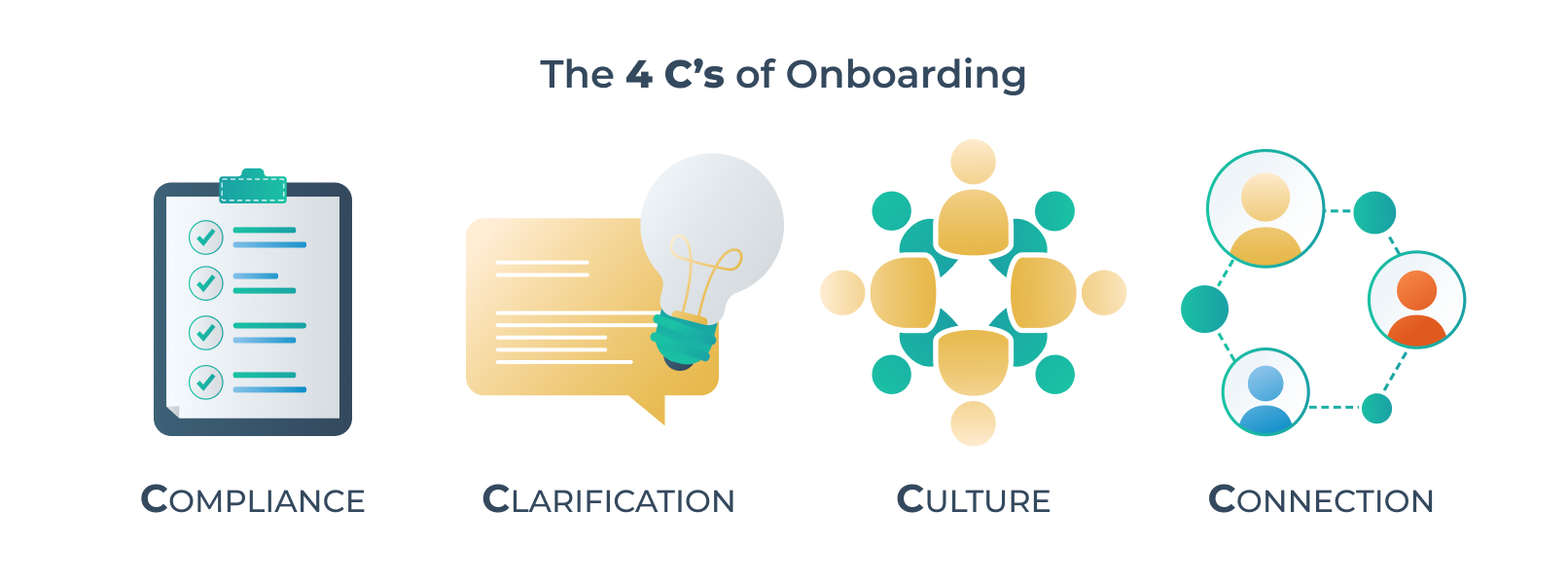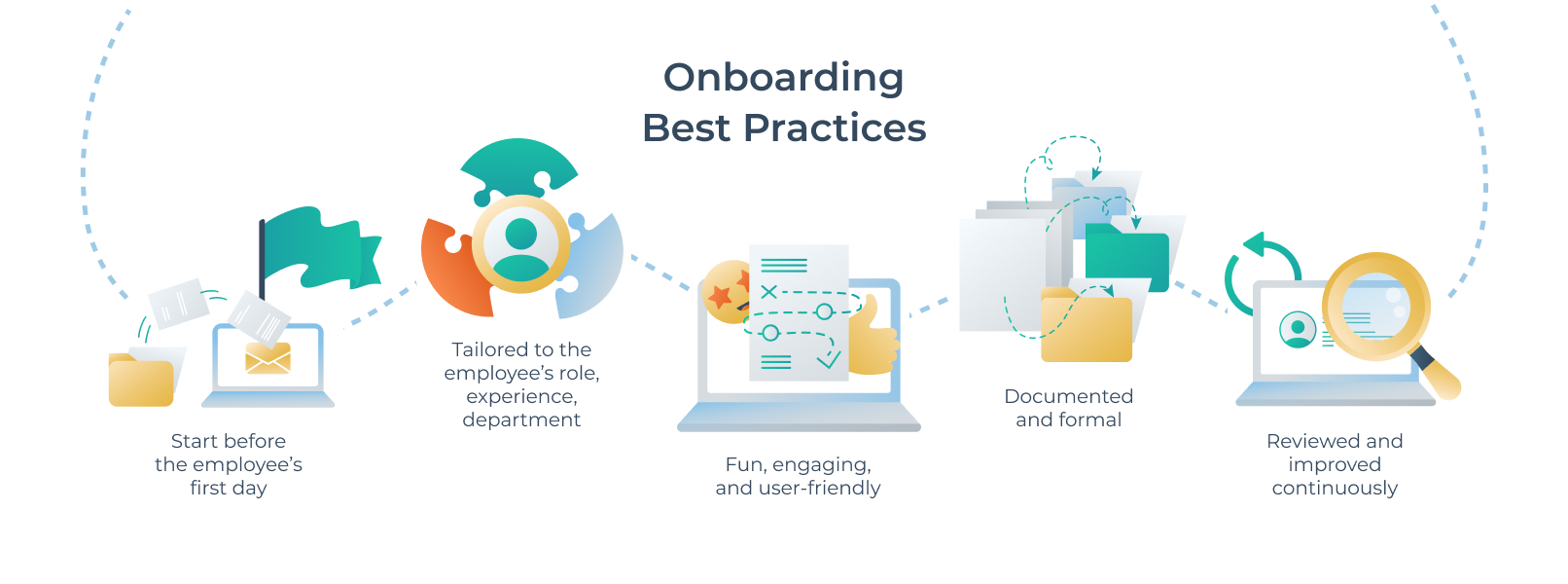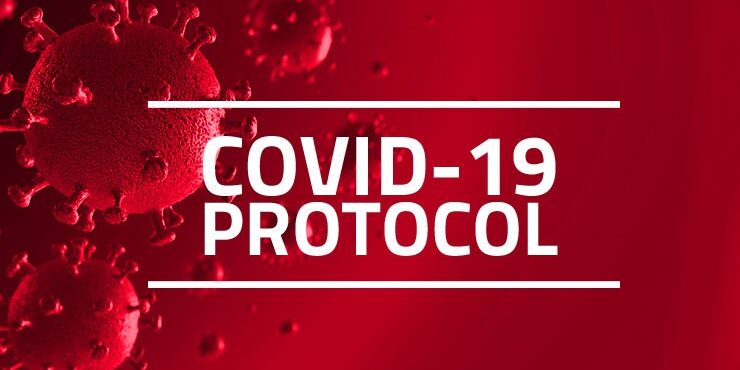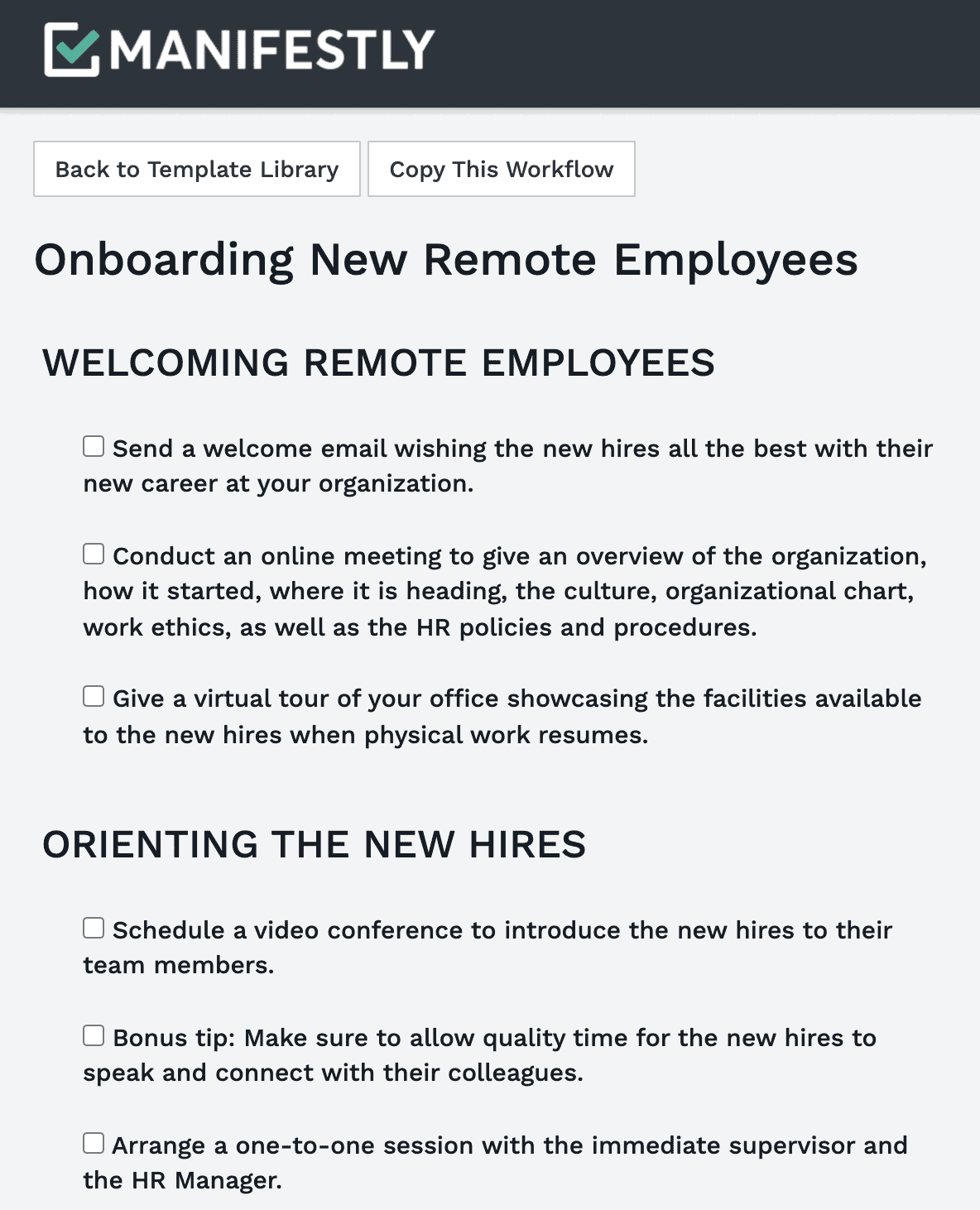Introduction
Whether you’re a small business owner or a large corporation, onboarding new employees is an important part of building your team. The process may seem overwhelming, but it doesn’t have to be. Your team can excel at employee onboarding by following a checklist for onboarding new employees to ensure that new employees are well-prepared for their new position in your organization.
If you are a small business owner, you may feel it’s impossible to compete with larger companies when it comes to hiring the best talent, but there are several ways in which you can attract the best candidates and make your organization stand out from the competition. One of these is by having a stellar onboarding process in place.
Why is employee onboarding so important?
Employee hiring and onboarding is an expensive process, not only in direct costs, but failures in onboarding lead to significant indirect losses for an organization, including low productivity, low retention, and poor customer service.
Recent research shows that employee onboarding costs companies $4,000 per hire, on average. However, when companies invest in a high-quality onboarding program and make it a priority, they can increase the return on investment by up to 200%.
Research by Brandon Hall Group found that organizations with a strong onboarding process improve new hire retention by 82 percent and productivity by over 70 percent.
In this article, we’ll share some of the best practices for creating a high-quality onboarding checklist, discuss different employee onboarding software platforms, and explain why it’s so important to your company’s bottom line.
Employee onboarding is an essential part of the employee lifecycle and is the foundation on which future success will be built. Onboarding provides an opportunity to engage and excite new hires as they get started in their new role.
The first impression you make on a new hire sets the stage for future success. If you’re not putting effort into your employee onboarding program, you’re setting yourself up for failure—not just in terms of retaining top talent but also because it’s hard to build a strong positive culture without it.
Employee onboarding is about more than just handing a new hire a manual and sending them off on their way. It’s a process that helps new employees start out on the right foot, learn what they need to know to be successful in their role, and feel welcome and valued by your company.
Why use an Onboarding Checklist?
An onboarding checklist is the best way to make sure the new hire experience is smooth, productive and enjoyable for the new employee, their team, and the staff in human resources.
Checklists can provide several benefits to an organization and the new employees:
- Checklists help you make sure you cover all the bases. They keep track of what’s been done so far and will help you ensure nothing has been missed in your planning.
- There is less room for mistakes and miscommunication when it comes to onboarding!
- They provide a step-by-step guide through what is expected or needed during their first week of work at your company so that no one misses anything important in the process.
- They help new employees understand what is expected of them and what they can expect from their new company. Checklists are a great tool for making sure everyone involved in the process is on the same page!
- Onboarding is a critical part of the employee experience. It’s the first impression they’ll have of your company and it can set the tone for their entire tenure with you.
- They are a basis for continuous improvement processes. If your organization does not have a documented process, it is difficult to continually analyze and improve the process.
Keep in mind a documented process of onboarding does not need to be complex and long in order to be valuable, so do not get overwhelmed if you’re starting from scratch. A simple one-page document is sufficient at first, but be sure to update it as needed over time.
The onboarding checklist should be a collaborative effort that includes line staff and managers but is typically led by Human Resources. By including everyone in the process, you will gain a better understanding of what is needed from day one and increase the chances that employees feel included, valued and supported by everyone at your company.
Definition of Onboarding
When introducing a new employee to your company, you’re onboarding them. The process of onboarding can be formal or informal, but it’s important to make sure you have the right tools in place.
The Society for Human Resource Management defines employee onboarding as “a process for welcoming new hires and orienting them to their organization.” Onboarding also includes training on how to do the job, and sometimes it’s integrated with other key HR processes, such as performance management.
New Employee Orientation vs Onboarding
New hire orientation and onboarding are two terms that can be used interchangeably, but they’re not exactly the same thing.
Orientation of new hires is a single event that occurs at the start of a new employee’s first day of work. It often involves meeting with HR and key members of your team to learn about your company’s history, culture, benefits package and policies.
Onboarding refers more generally to an entire process—one that usually continues beyond orientation — of helping new employees acclimate to their roles at your business: teaching them how to use your technology systems; introducing them to colleagues and clients; answering questions about how things work around the office; getting them on board with company procedures for things like expense reports or travel arrangements.
If you’d like more clarity on the difference check this article on new employee onboarding and orientation, by Indeed.
The Four Phases of Employee Onboarding
The Society for Human Resource Management lists four phases in their article Understanding Employee Onboarding.
- Preboarding: The first phase is preboarding, which takes place before the employee begins work. This includes things like filling out paperwork and getting accounts set up such as email and Slack.
- Orientation: The second phase is orientation, which is when you train your new employees on company policies and procedures as well as software systems they’ll be using.
- Foundation: The foundation building phase is where you teach them about their role in the organization and how they fit into the greater picture of what’s happening with the company as a whole.
- Mentoring: The final phase is mentoring. This is where you provide ongoing support for your employees, including regular check-ins and feedback sessions.
The Four Cs of Onboarding

There are many ways to think about employee onboarding and one common model is the four Cs of compliance, clarification, culture, and connection.
Compliance: The first C is compliance. Compliance refers to ensuring that all of the new employee’s paperwork is filled out, they’ve been through orientation, and they have any necessary training completed before they start work with your organization.
Clarification: The second C is clarification. This involves taking the time to make sure that everyone knows what they’re expected to do when they start work at your company, including the employee’s role in the organization and how it fits into the bigger picture.
Culture: The third C is culture which refers to helping new employees understand what makes your organization unique and special, as well as how their individual contributions fit in with that culture. Culture is important because it can help new employees fit into the company much more easily. After all, if they don’t understand what makes your organization special, they won’t be able to do their jobs well.
Connection: The fourth C is connection. This refers to taking the time to get new employees connected with their coworkers, whether through lunch or coffee breaks, group activities or team meetings. Connection is also about helping new employees feel like they belong, that they’re not just another cog in the wheel but an integral part of your organization.
Onboarding Best Practices

- Employee onboarding is a multi-faceted process that should begin before an employee starts work and continue after they’re hired.
- It should be standardized, but also tailored to the employee’s role, experience, and position in your organization.
- The onboarding process should involve both the new hire and his or her manager in order to ensure successful integration into the team and workplace culture.
- Employee onboarding should be fun, engaging and user-friendly in order to make employees feel comfortable with their new environment/workplace culture/team members/etc., so they can really get down to business!
- The onboarding process should be formal and documented, providing a mechanism for review and evaluation. It should also be a continuous process and include formal and informal activities to ensure that employees are being properly supported in their new roles.
- Lastly, your employee onboarding process should be reviewed and improved continuously.
Inclusive Onboarding Experience
The onboarding process should be an inclusive, welcoming experience. When you’re building a checklist for your new employee orientation, make sure that you’re thinking about the needs of all parties involved: the new employee, your company and its culture (and how it might differ from their past work environment), as well as any team members who will be working with them on day one or during the first few weeks in their position.
Every aspect of this checklist should be tailored to ensure that there are no surprises later on down the line when any party discovers something about another’s expectations that could have been avoided by more careful planning during onboarding. If a new hire feels like they’ve been misled at any time during their first days working at your organization—whether it’s due to information being withheld from them or because someone made assumptions about what they could handle based on gender/race/sexuality—this can cause serious problems for morale later on down the line when employees feel like management isn’t taking into account their needs and interests outside of work hours
Onboarding Platforms
An onboarding platform is a software system that helps you manage the processes involved in getting employees up to speed. It can be used to:
- Manage documentation, policies and procedures
- Assign tasks to new employees
- Record data about employee progress
- Notify assignees of upcoming or late tasks
Onboarding platforms are especially useful for companies looking to limit their costs by using technology instead of hiring additional staff members or outsourcing their company’s onboarding process to a third party.
Some of the top employee onboarding platforms as reviewed on Capterra.
This Zapier list of the top employee onboarding platforms.
As a general-purpose workflow management solution, Manifestly is used by thousands of human resource professionals as a robust employee onboarding platform.
A Process of Continuous Improvement
One of the most overlooked aspects we’ve seen is a lack of formal process improvement with your onboarding Workflow. Every time the onboarding workflow is used brings an opportunity to collect data, both quantitative and qualitative, on the process. The new hire as well as those in your organization involved onboarding the new hire should participate in an after action review to discuss and document what went right and went didn’t go so well.
We recommend having a place (such as a cloud based document or a ticket system) for staff to continually provide ideas on the process. Also, a workflow management tool like Manifestly, can provide quantitative data on each person onboarded – how long tasks took, whether a task was late, etc.
With a process of continuous improvement, your team should have the confidence that missing any steps in the creation of the workflow will be rectified during the improvement process – so start small. Your onboarding workflow should be viewed one that is continually changing as your bring on new systems, new rules, and new employee roles.
How to Create a Great Employee Onboarding Checklist
As described above, a method of start small, build from there, will help your team create amazing processes. You don’t need to have everything in place when you start. Your checklist will be a living document that can be updated over time as you learn more about your company’s employees and the best ways to onboard them. Here are some of the most important things to consider when creating an employee onboarding checklist:
- What do we want our employees to know and understand about their roles?
- How can we improve the onboarding experience for both new hires and their managers?
- What is the best way for us to communicate these things so that they are retained by employees?
- How can we make sure that new hires are able to learn and apply what they need to know?
- What process do we want new hires and their managers to follow?
- What resources will help them get started and provide ongoing support as they progress through their roles?
- How will we measure success? What are the metrics by which we will measure how well our onboarding process is working?
Some Ideas for Your Employee Onboarding Checklist
Before the first day
Before the first day, you can set up some things that will help your new hire feel comfortable and ready to start working.
- Send a welcome email when you know the date of their first day. If possible, provide access to documents, tools and resources that they’ll need in their workday. You can do this through an onboarding software tool like Manifestly or by sharing links on Slack or Microsoft Teams in real time over the course of several days before their first day.
- Make sure everyone knows who the new hire. Even if all your company hires come from within, there’s still a chance that someone might not remember who your new employee is when he or she arrives for orientation, so have the new hire help in writing up their introduction, with a picture.
- Write something welcoming into Slack or Microsoft Teams channels welcoming the new hire. This could be as simple as “Welcome [Name], thrilled we’re getting started together!”
- Make sure you have a clear idea of what your new hire will be doing on their first day. You don’t want to overwhelm them with too many tasks — especially if they’ve never worked in your industry before — so ask yourself: What is the most important thing we need to accomplish by the end of their first day?
- Provide them with the outline of your onboarding checklist, at the very list have the steps that they will be involved with – you don’t need to include some of the steps that are completed behind the scene by HR, IT, and accounting.
- Figure out who is going to be the new hire’s “buddy/mentor” during their first week.
Day 1
- Introduce the new employee to their team.
- Give an overview of the company culture and vision.
- Introduce the “buddy/mentor” to the new hire.
- Provide an overview of the onboarding process and schedule a 1:1 meeting with your manager.
- Introduce them to and ensure everything is working properly with their email, phone, computer and other equipment they will need to do their job effectively.
- Introduce them to their colleagues and other important people in the company (including mentors/buddies).
- Show them around their workplace, including private offices if applicable; show where things like printers/copiers are located; introduce anyone who may be working remotely at that moment so they can meet face-to-face if possible before proceeding with training sessions or other activities instead.)
Introduce them to their manager and the rest of your team. Give a brief overview of onboarding process and schedule 1:1 meetings with your manager and other key stakeholders in the company (including mentors/buddies). Set up their email, phone, computer and other equipment they will need to do their job effectively.
Week 1
Week 1 is all about getting the new employee up to speed and ready to go. We want them to have a smooth transition into our company, so it’s important that we set expectations and make sure they’re clear on what’s expected of them.
Week 2
Week 2 is all about getting the new employee up to speed on their work. It’s also important that they understand how to use the various tools available at their new company (email, Slack, etc.) so that they can become productive quickly and have a feeling of contributing to the success of the organization.
First 30 days
The first thirty days are when you establish relationships and build trust, set the tone for future performance, and make sure that your new employee feels comfortable in their new role. It’s also a critical time to:
- Make sure they understand what is expected of them.
- Give them an opportunity to ask questions.
- Give yourself an opportunity to answer questions if you don’t know something right away (you can look it up later).
Establish a plan for their success. Make sure they have everything they need to succeed.
First 90 days
The first 90 days is a critical period for new hires, as it’s when you expect them to get their feet wet and start contributing. Here are some things to consider during that time:
- What should the new hire expect from his or her manager?
- What should the team expect from your new hire?
- What should HR expect from your new hire?
- What can we all expect from our company during this period of transition?
- What does the new hire think of this onboarding process? How could it be improved?
Frequently-Asked-Questions
-
What is onboarding?
Onboarding is the process of welcoming new hires into an organization and helping them feel comfortable, connected and productive. It’s a process that can begin as soon as you accept an offer, and the best practice is to start the process before the first day on the job. In addition to getting new hires up to speed with their work duties, onboarding also includes training on the company’s culture, policies and procedures. It’s a time to get to know each other and build relationships that will last beyond the first few months. -
Why is onboarding important?
Onboarding is important because it helps set the tone for a new employee’s experience at your company. If you have a well-defined and implemented onboarding process, it will help build trust in your organization by showing that someone cares about the newcomer’s transition into the organization. A strong onboarding program also reduces attrition rates by helping new hires feel more connected to the company and its culture. -
What are the stages of onboarding?
There are four stages of onboarding that every organization should implement:- Stage 1: Orientation – This is the first step in getting a new hire up to speed with the company’s culture and processes. It usually happens within the first week of employment and typically includes some combination of training and shadowing other employees.
- Stage 2: Assimilation – This is when a new hire becomes familiar with the company’s culture and begins to feel like an accepted member of the team. It typically takes place during the first month on the job and includes activities such as social events, lunches with colleagues, and learning about benefits.
- Stage 3: Acclimation – This is when a new hire becomes an active contributor to the team. It typically takes place during the first six months on the job and includes activities such as training in new skills, mentoring by more senior employees, and working on projects with teams other than their own.
- Stage 4: Adoption – This is when a new hire begins to take ownership of his or her responsibilities and fully integrates into the company culture.
-
How long does it take to onboard a new employee?
The length of time it takes to onboard a new hire depends on the type of position, level of experience, and industry. According to the Society for Human Resource Management (SHRM), it takes an average of seven weeks for employees with no prior experience in their roles to become fully productive and a comprehensive onboarding process involving management and other employees can last up to 12 months. -
How do you onboard a remote employee?
Many companies use a combination of online resources and in-person meetings to onboard their remote employees. The primary tools for remote onboarding include training videos, webinars, employee handbooks, FAQs and other documents that explain the company’s policies, procedures and benefits. -
What is the difference between onboarding and training?
Training is a subset of onboarding. In general, training is the process of teaching someone to perform a task or function related to their job. Onboarding, on the other hand, is a broader process to not only help new hires learn how to do their job, but also to help new hires learn about your company culture and how they can be successful there.
Checklist Templates
Manifestly has several workflow templates for onboarding employees in our templates library.
Onboarding a Software Developer Workflow Template
Employee Onboarding Checklist Template
Template for Onboarding Remote Employees
Offboarding Employees
Offboarding employees is the process of terminating an employee’s employment. It’s a critical part of the onboarding process and should be handled with care. When you include your new hires in the offboarding process, it helps them understand that they aren’t being fired and provides them with information about their benefits.
- Create a checklist for offboarding employees using this template: https://goo.gl/pamKD5
- Print out copies of the checklist so that all involved parties can keep track of what needs to be done during each stage of the offboarding process.
You may also want to use this checklist as a reference when hiring new employees. When you conduct interviews and hire new employees, make sure you ask them about their expectations for the onboarding process and what they need in order to feel comfortable at work.
Conclusion
Employee onboarding programs are an essential part of the employee lifecycle. They can help new hires become more productive and engaged employees who are likely to stay with your company for a long time. If you have any questions about employee onboarding programs or how to improve yours, feel free to ask us on Twitter, LinkedIn, or Facebook.
Manifestly Employee Onboarding Templates
We provide several employee onboarding templates in our checklist template library.
Onboarding a New Software Developer




